View in other NatureServe Network Field Guides
NatureServe
Montana
Utah
Wyoming
Idaho
Wisconsin
British Columbia
South Carolina
Yukon
California
New York
Leafy Pondweed - Potamogeton foliosus
Native Species
Global Rank:
G5
State Rank:
SNR
C-value:
6
Agency Status
USFWS:
USFS:
BLM:
External Links
General Description
PLANTS: Aquatic perennials with slightly compressed and branched stems. Turions (overwintering buds) are uncommon. Rhizomes are absent. Sources: Lesica et al. 2012; Haynes and Hellquist in Flora of North America (FNA) 2000.
LEAVES: Submersed leaves attached directly to the stem. Submersed leaves are linear, 1 to 4 cm long by about 1 mm wide. Stipules are 5 to 10 mm long, sheath the stem but often fray above. Floating leaves are absent. Source: Lesica et al. 2012.
INFLORESCENCE: Small flowers are arranged in unbranched, capitate spikes that are 1 to 6 mm long and emersed. Sources: Lesica et al. 2012; Haynes and Hellquist in FNA 2000.
The specific epithet foliosus translates directly from Latin meaning leafy (Merriam-Webster 2019). Potamogeton is derived from the Greek words potamos meaning river and geiton meaning neighbor (Merriam-Webster 2019; Pilon et al. 2002).
Phenology
The flowering period of Leafy Pondweed occurs in mid- to late-summer (Hilty 2017).
Diagnostic Characteristics
Montana has 21
Potamogeton species. They are all aquatic perennials with submergent leaves, but some species also have floating leaves, often of a different shape. All species have small, sessile flowers arranged in a cylindrical spike with a long stem (peduncle) that grows from the axil of a leaf.
Many floras have split
Potamogeton into two genera based on molecular evidence and the following morphology (Haynes and Hellquist
FNA 2000; Giblin et al. [eds.] 2018):
Potamogeton
*Floating leaves present or absent.
*Submersed leaves: Stipule is free from the leaf blade, or if attached the fused (adnate) portion is 5 mm or less and no more than half the stipule’s length.
*Submersed leaf blades are translucent, not channeled, and are flat.
*Peduncle of the inflorescence is stiff and can project above the water.
*18 Montana species.
Stuckenia
*Floating leaves never present.
*Submersed leaves: At least two-thirds of the stipule is adnate to the base of the leaf, usually for more than 10 mm and it forms a sheath around the stem.
*Submersed leaf blades are opaque, channeled, and are turgid.
*Peduncle of the inflorescence is flexible and does not project above the water (is submersed).
*3 Montana species.
Leafy Pondweed-Potamogeton foliosus, native
* Montana plants are variety foliosus.
*Stems: Slightly compressed and branched and lacking globose glands at the nodes.
*Floating Leaves: absent.
*Submersed Leaves: Linear, 1-4 cm long and about 1 mm wide, and attached directly to the stem at the base of the stipule.
*Stipules: 5-10 mm long and sheathing but frying above.
*Spikes: 1-6 mm long and capitate.
*Tepals: Green and =1 mm long.
*Achenes: 1.5-2 mm long. Abaxial keel is wing-like and beak is erect, 0.2-0.6 mm.
*A combination of linear leaves and fruits with an undulating, wing-like abaxial keel (not lateral keel) are most likely this species.
Blunt-leaved Pondweed-Potamogeton obtusifolius, native, SOC
*Stems: Slightly compressed and branched with globose glands at the nodes.
*Floating Leaves: absent.
*Submersed Leaves: Linear, 3-8 cm long and 2-4 mm wide, with a blunt tip, and attached directly to the stem at the base of the stipule.
*Stipules: 1-2 cm long, membranous, and sheathing.
*Spikes: About 1 cm long.
*Tepals: Green and about 1 mm long
*Achenes: Barely keeled and 3-3.5 mm long including the erect beak.
Curly-leaf Pondweed-Potamogeton crispus, exotic, noxious
*Stems: Slightly flattened and mostly straight.
*Floating Leaves: absent (though stems break off and float).
*Submersed Leaves: Mature leaf blades clasp the stem, are linear to oblong with wavy margins (like a lasagna noodle) and minute teeth. Leaves lack a stem (petiole).
Slender Pondweed-Potamogeton filiformis, native
*Stems: Cylindrical (terete) and branched. Less branched above.
*Floating Leaves: absent.
*Submersed Leaves: Filiform, 1-8 cm long and 1-2 mm wide, and attached directly to the stipule (not the stem). Leaf tip acute to acuminate or blunt or asymmetrically notched. Leaf tapers only within the last 1 mm of the tip.
*Stipules: Lower stipule 5-15 mm long and sheathing. Tip of stipule extends as a ligule up to 20 mm beyond their junction with the base of the leaf blade.
*Spikes: 1-5 cm long with distinct whorls of flowers.
*Tepals: Brownish and 1-2 mm long.
*Achenes: 2-3 mm long and obscurely keeled with a minute beak.
*Rhizomes not tuberous.
*Often confused with Potamogeton vaginatus or Potamogeton pectinatus.
Sheathed Pondweed-Potamogeton vaginatus, native
*Stems: Cylindrical (terete) and branched.
*Floating Leaves: absent.
*Submersed Leaves: linear, 2-10 cm long and 1-2 mm wide, and attached directly to the stipule (not the stem).
*Stipules: Lower stipule 1-5 mm long and sheathing, brown, and swollen at the base. Tip of stipule extend as a ligule, 0-2mm beyond their junction with the base of the leaf blade.
*Spikes: 1-5 cm long with well-separated whorls of flowers.
*Tepals: Brownish-green and 1-2 mm long.
*Achenes: 2-3(-3.8) mm long and obscurely keeled and beaked.
*Often confused with Potamogeton filiformis or Potamogeton pectinatus.
Sago Pondweed-Potamogeton pectinatus, native
*Stems: Cylindrical (terete)and branched. Highly branches, especially above.
*Floating Leaves: absent.
*Submersed Leaves: Filiform, 1-10 cm long and <1 mm wide, and attached directly to the stipule (not the stem). Leaf tip acute to acuminate, apiculate, or mucronate on young plants. Leaf tapers within the last 3 mm of the tip.
*Stipules: Lower stipules 1.5-30 mm long, tightly sheathing, but not swollen. Tip of stipule extends as a ligule up to 20 mm beyond their junction with the base of the leaf blade.
*Spikes: 1-5 cm long with distinct whorls of flowers.
*Tepals: Brownish-green and 1-1.5 mm long.
*Achenes: 3-4 mm long and obscurely keeled with a slender, curved beak.
*Rhizomes tuberous.
*Often confused with Potamogeton filiformis or Potamogeton vaginata.Species Range
Montana Range
Range Descriptions
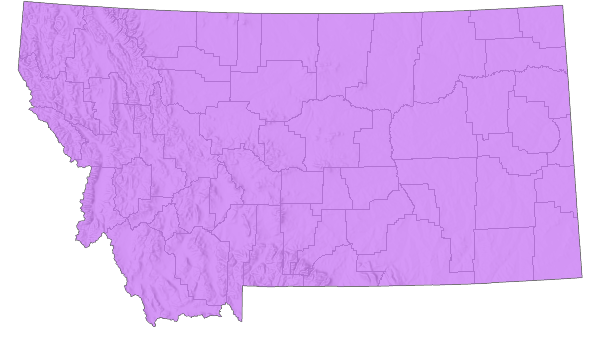
 Native
Native
Range Comments
Leafy Pondweed can be found throughout temperate North America (Lesica et al. 2012).
Observations in Montana Natural Heritage Program Database
Number of Observations: 2036
(Click on the following maps and charts to see full sized version)
Map Help and Descriptions
Relative Density
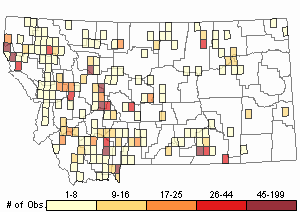
Recency
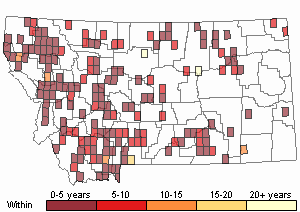
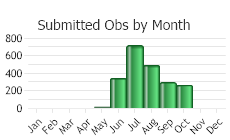
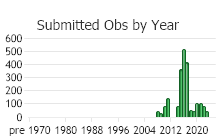
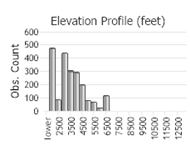 (Observations spanning multiple months or years are excluded from time charts)
(Observations spanning multiple months or years are excluded from time charts)
Habitat
Leafy Pondweed prefers the shallow, fresh water of ponds, ditches, and sloughs in the valleys of Montana (Lesica et al. 2012).
Ecology
ALLELOPATHIC POTENTIAL
Potamogeton species contain terpenoids and alkaloids, both potential allelochemicals (Gao et al. 2017). Allelochemicals are biochemicals released by plants that affect the growth, health, behavior, or population biology of other organisms around them (Gao et al 2017). Terpenoids in the forms of essential oils and monoterpenes strongly inhibit seed germination and plant growth (Fischer et al. 1994). Both terpenoids and alkaloids may cause plants to be bitter tasting or even toxic for herbivores (Harborne 1993).
The allelopathic effects of Potamogeton may be species specific (Gao et al. 2017). Effects were tested of two Potamogeton species on two algae species, Raphidocelis subcapitata and Microcystis aeruginosa. Potamogeton maackianus was found to show stronger inhibition on Microcystis aeruginosa while the inhibitory effects of Potamogeton malaianus were stronger on Raphidocelis subcapitata.
Leafy Pondweed has also been seen to affect the survivorship of Diaptomus clavipes, a copepod (Gehrs et al. 1974). In a study done on the horizontal distribution of Diaptomus clavipes in relation to Leafy Pondweed, a highly significant proportion of the copepods preferred living in open water rather than near pondweed that grew to within 40 cm of the pond’s surface. When forced to coexist with Leafy Pondweed in a laboratory setting, most Diaptomus clavipes individuals died. It is unclear whether the effect the plant was having on Diaptomus clavipes was physical or chemical.
Reproductive Characteristics
FLOWERS
The flowers of Leafy Pondweed are small and inconspicuous and arranged in unbranched, capitate spikes that are 1 to 6 mm long (Lesica et al. 2012). The tepals are green and up to 1 mm long (Lesica et al. 2012).
FRUIT
The mature fruit of Leafy Pondweed are ovoid achenes that are 1.5 to 2 mm long and keeled with a minute, erect beak (Lesica et al. 2012). They are olive to green-brown (Haynes and Hellquist in FNA 2000).
LIFE CYCLE
Leafy Pondweed begins its blooming period in mid- to late-summer and lasts up to 4 weeks after which flowers are replaced by achenes (Hilty 2017). Turions, when present, develop during the growing season, sink and overwinter in mud, and can develop into new plants the following spring (Lesica et al. 2012).
HYBRIDIZATION
Potamogeton species are well known for being one of the most common genera to hybridize with each other (Du et al. 2010). A possible hybrid between Leafy Pondweed and Small Pondweed (Potamogeton pusillus) has been observed in North America (Kaplan et al. 2009). In China, Leafy Pondweed often hybridizes with P. octandrus (Du et al. 2010).
Stewardship Responsibility
References
- Literature Cited AboveLegend:
 View Online Publication
View Online Publication Hitchcock, C.L. and A. Cronquist. 2018. Flora of the Pacific Northwest: An Illustrated Manual. Second Edition. Giblin, D.E., B.S. Legler, P.F. Zika, and R.G. Olmstead (eds). Seattle, WA: University of Washington Press in Association with Burke Museum of Natural History and Culture. 882 p.
Hitchcock, C.L. and A. Cronquist. 2018. Flora of the Pacific Northwest: An Illustrated Manual. Second Edition. Giblin, D.E., B.S. Legler, P.F. Zika, and R.G. Olmstead (eds). Seattle, WA: University of Washington Press in Association with Burke Museum of Natural History and Culture. 882 p. Lesica, P., M.T. Lavin, and P.F. Stickney. 2012. Manual of Montana Vascular Plants. Fort Worth, TX: BRIT Press. viii + 771 p.
Lesica, P., M.T. Lavin, and P.F. Stickney. 2012. Manual of Montana Vascular Plants. Fort Worth, TX: BRIT Press. viii + 771 p.
- Additional ReferencesLegend:
 View Online Publication
View Online Publication
Do you know of a citation we're missing? Gillespie, D.M. 1966. Population studies of four species of mollusks in the Madison River, Yellowstone National Park. Ph.D. Dissertation. Bozeman, Montana: Montana State University. 43 p.
Gillespie, D.M. 1966. Population studies of four species of mollusks in the Madison River, Yellowstone National Park. Ph.D. Dissertation. Bozeman, Montana: Montana State University. 43 p. Lesica, P., M.T. Lavin, and P.F. Stickney. 2022. Manual of Montana Vascular Plants, Second Edition. Fort Worth, TX: BRIT Press. viii + 779 p.
Lesica, P., M.T. Lavin, and P.F. Stickney. 2022. Manual of Montana Vascular Plants, Second Edition. Fort Worth, TX: BRIT Press. viii + 779 p.
- Web Search Engines for Articles on "Leafy Pondweed"





